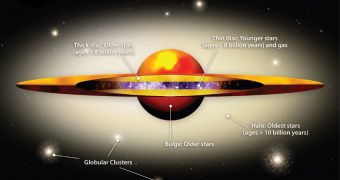For the first time since astronomers have been observing the Andromeda Galaxy, a group of scientists was able to identify a thick stellar disk surrounding the closest galaxy to the Milky Way.
The group – which was made up of experts from the UK, the US and Europe – is bound to provide additional insights into generally-valid processes that shape the formation of spiral galaxies.
Andromeda and the Milky Way are massive spiral galaxies, that are among the largest structures of this type known. They evolved over billions of years to reach their current sizes, and consumed numerous dwarf galaxies in the process.
This type of behavior gave birth to a series of physical phenomena that played an important role in the overall outcome of the galaxies' evolution. Experts hope to tease them out by studying the newly-discovered structure surrounding our neighbor.
Using the W.M. Keck Observatory atop Mauna Kea, in Hawaii, the researchers were able to analyze the velocities of individual stars in the Andromeda galaxy. This in turn allowed them to tease out the existence of the thick stellar disk from the already-known thin one.
Furthermore, the team was able to determine how the larger disk differed from the smaller one, in terms of height, widths and chemistry. In spiral galaxies, as a general rule, 70 percent of all stars are located in flat stellar discs.
It's these disks that differentiate into spiral arms. Each spiral galaxy has two, three or more spiral arms. At the boundaries of each such arm, astronomers tend to discover areas of intense stellar formations, called stellar nurseries.
They develop because masses of hydrogen gas and cosmic dust at these locations are stirred up by the interactions between the arms and the rest of the galaxy. At the core of spiral galaxies lies a central bulge made up of old, red stars, that revolve around a supermassive black hole.
“From observations of our own Milky Way and other nearby spirals, we know that these galaxies typically possess two stellar discs, both a ‘thin’ and a ‘thick’ disc,” says study leader Michelle Collins.
She holds an appointment as a PhD student at the Cambridge University Institute of Astronomy. The expert says that the thick disk in Andromeda becomes visible when looking for older stars that orbit above or below the standard, thin stellar disc.
“The classical thin stellar discs that we typically see in Hubble imaging result from the accretion of gas towards the end of a galaxy’s formation, whereas thick discs are produced in a much earlier phase of the galaxy’s life, making them ideal tracers of the processes involved in galactic evolution,” says Collins.
“Our initial study of [the thick stellar disc] already suggests that it is likely older than the thin disc, with a different chemical composition,” argues Mike Rich, an astronomer at the University of California in Los Angles.
“Future more detailed observations should enable us to unravel the formation of the disc system in Andromeda, with the potential to apply this understanding to the formation of spiral galaxies throughout the Universe,” he concludes.
Details of the new observation appear in a scientific paper published in the latest issue of the esteemed journal Monthly Notices of the Royal Astronomical Society, Universe Today reports.

 14 DAY TRIAL //
14 DAY TRIAL //